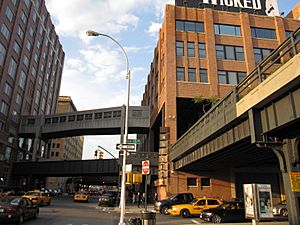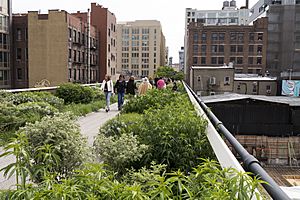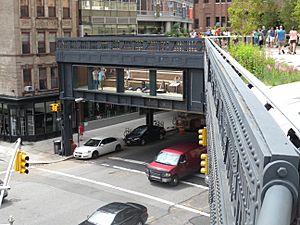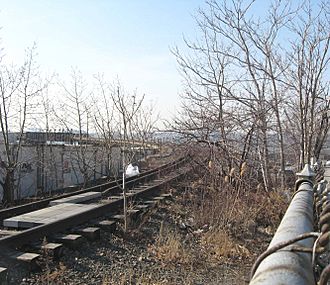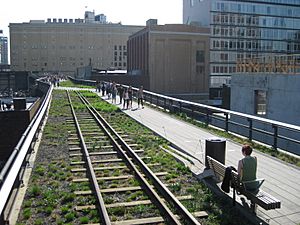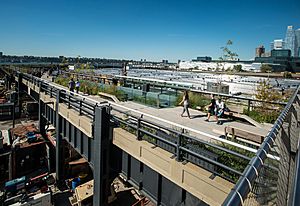High Line facts for kids
Quick facts for kids High Line |
|
|---|---|
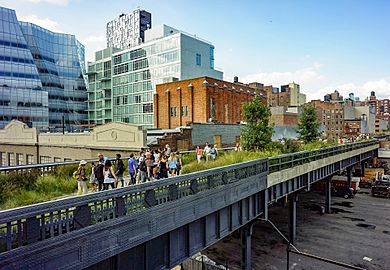
The High Line by 18th Street
|
|
|
Interactive route mapInteractive route map [show]
<mapframe frameless width="220" height="590" zoom="15" latitude="40.747633" longitude="-74.004886" align="center">
[ { "type": "ExternalData", "service": "geoshape", "ids": "Q843869", "properties": { "stroke": "#325b32", "stroke-width": 2, } }, { "type": "Feature", "geometry": { "type": "Point", "coordinates": [-74.008202, 40.739502]}, "properties": { "title": "Gansevoort St: elevator and stairs", "marker-size": "small", "marker-symbol": "disability" } }, { "type": "Feature", "geometry": { "type": "Point", "coordinates": [-74.007871, 40.741890]}, "properties": { "title": "14th St: elevator and stairs", "marker-size": "small", "marker-symbol": "disability" } }, { "type": "Feature", "geometry": { "type": "Point", "coordinates": [-74.006973, 40.743417]}, "properties": { "title": "16th St: elevator and stairs", "marker-size": "small", "marker-symbol": "disability" } }, { "type": "Feature", "geometry": { "type": "Point", "coordinates": [-74.006045, 40.745962]}, "properties": { "title": "20th St: stairs", "marker-size": "small", "marker-symbol": "entrance" } }, { "type": "Feature", "geometry": { "type": "Point", "coordinates": [-74.004712, 40.747814]}, "properties": { "title": "23rd St: elevator and stairs", "marker-size": "small", "marker-symbol": "disability" } }, { "type": "Feature", "geometry": { "type": "Point", "coordinates": [-74.003376, 40.749916]}, "properties": { "title": "26th St: stairs", "marker-size": "small", "marker-symbol": "entrance" } }, { "type": "Feature", "geometry": { "type": "Point", "coordinates": [-74.002543, 40.751074]}, "properties": { "title": "28th St: stairs", "marker-size": "small", "marker-symbol": "entrance" } }, { "type": "Feature", "geometry": { "type": "Point", "coordinates": [-74.001949, 40.752334]}, "properties": { "title": "30th St: elevator and stairs", "marker-size": "small", "marker-symbol": "disability" } }, { "type": "Feature", "geometry": { "type": "Point", "coordinates": [-74.003988, 40.753423]}, "properties": { "title": "30th St and 11th Ave: stairs", "marker-size": "small", "marker-symbol": "entrance" } }, { "type": "Feature", "geometry": { "type": "Point", "coordinates": [-74.001077, 40.752158]}, "properties": { "title": "30th St and 10th Ave: stairs", "marker-size": "small", "marker-symbol": "entrance" } }, { "type": "Feature", "geometry": { "type": "Point", "coordinates": [-74.003671, 40.756319]}, "properties": { "title": "34th St: accessible ramp", "marker-size": "small", "marker-symbol": "disability" } } ] </mapframe>Hover over each pin for information |
|
| Type | Elevated urban linear park; public park |
| Location | Manhattan, New York City |
| Area | A linear 1.45-mile (2.33 km) stretch of viaduct |
| Created | 2009 |
| Operated by | New York City Department of Parks and Recreation |
| Visitors | 8 million (2019) |
| Status | Operating |
| Public transit access | New York City Subway: 34th St–Hudson Yards ( 14th Street–Eighth Avenue ( New York City Bus: M11, M12, M14A, M14D, M23 SBS, M34 SBS at various places |
| Website | www.thehighline.org |
The High Line is a 1.45-mile-long (2.33 km) elevated linear park, greenway and rail trail created on a former New York Central Railroad spur on the west side of Manhattan in New York City. The High Line's design is a collaboration between James Corner Field Operations, Diller Scofidio + Renfro, and Piet Oudolf. The abandoned spur has been redesigned as a "living system" drawing from multiple disciplines which include landscape architecture, urban design, and ecology. Since opening in June 2009, the High Line has become an icon of contemporary landscape architecture.
The park is built on a disused, southern viaduct section of the New York Central Railroad's West Side Line. Originating in the Meatpacking District, the park runs from Gansevoort Street – three blocks below 14th Street – through Chelsea to the northern edge of the West Side Yard on 34th Street near the Javits Center. The West Side Line formerly extended south to a railroad terminal at Spring Street, just north of Canal Street, and north to 35th Street at the site of the Javits Center. Due to a decline in rail traffic along the rest of the viaduct, it was effectively abandoned in 1980 when the construction of the Javits Center required the demolition of the viaduct's northernmost portion. The southern portion of the viaduct was demolished in segments during the late 20th century.
The High Line was inspired by the 4.7 km (2.9 mi) long Promenade plantée (tree-lined walkway), a similar project in Paris completed in 1993. Repurposing the railway into an urban park began in 2006 and opened in phases during 2009, 2011, and 2014. The Spur, an extension of the High Line that originally connected with the Morgan General Mail Facility at Tenth Avenue and 30th Street, opened on June 4, 2019, as the final part of the park to open.
The High Line's success has inspired cities throughout the United States to redevelop obsolete infrastructure as public space. The park became a tourist attraction and spurred real estate development in adjacent neighborhoods, increasing real-estate values and prices along the route. By September 2014, the park had nearly five million visitors annually, and by 2019, it had eight million visitors per year.
Contents
Description
The park extends for 1.45 miles (2.33 km) from Gansevoort Street to 34th Street. At 30th Street the elevated tracks turn west around the Hudson Yards Redevelopment Project to the Jacob K. Javits Convention Center on 34th Street, although the northern section is expected to be integrated with the Hudson Yards development and the Hudson Park and Boulevard. When the Hudson Yards Redevelopment Project's Western Rail Yard is finished in 2018 it will be elevated above the High Line Park, so an exit along the viaduct over the West Side Yard will lead to the Western Rail Yard. The 34th Street entrance is at grade, with wheelchair access.
The park is open daily from 7 a.m. to 7 p.m. in winter, until 10 p.m. in spring and fall, and until 11 p.m. in summer (except for the Interim Walkway west of 11th Avenue, which is open until dusk). It can be reached through eleven entrances, five of which are accessible to people with disabilities. The wheelchair-accessible entrances, each with stairs and an elevator, are at Gansevoort, 14th, 16th, 23rd, and 30th Streets. Additional staircase-only entrances are located at 18th, 20th, 26th, and 28th Streets, and 11th Avenue. Street-level access is available at 34th Street via the Interim Walkway, which runs from 30th Street and 11th Avenue to 34th Street west of 11th Avenue.
Route
At the Gansevoort Street end (which runs north-south), the stub over Gansevoort Street is named the Tiffany and Co. Foundation Overlook and was dedicated in July 2012; the foundation was a major supporter of the park. The route then passes under The Standard, High Line hotel and through a passage at 14th Street. At 14th Street, the High Line splits into two sides at different elevations; the Diller-Von Furstenberg Water Feature (opened in 2010) is on the lower side, and a sundeck is on the upper side.
The route passes under the Chelsea Market, a food hall, at 15th Street. A spur, connecting the viaduct to the National Biscuit Company building and closed to the public, splits off at 16th Street. The railroad tracks on the spur are left in situ but the trackbeds are planted with greenery. The Tenth Avenue Square, an amphitheater on the viaduct, is at 17th Street where the High Line crosses over Tenth Avenue from southeast to northwest. At the 23rd Street Lawn, visitors can rest. Between 25th and 26th Streets a ramp takes visitors above the viaduct, with a scenic overlook facing east at 26th Street. The Philip Falcone and Lisa Maria Falcone Flyover, named after two major donors to the park, was based on plans for a Phase 1 flyover which was never built.
The park then curves west to Phase 3 and merges into the Tenth Avenue Spur, which stretches over 30th Street to Tenth Avenue. The Tenth Avenue Spur is composed of three parts: the Coach Passage, with 60-foot-tall (18 m) ceilings; the High Line's largest planted garden; and a plaza with temporary art exhibitions that get replaced every 18 months. Phase 3 has another ramp taking visitors above the viaduct at 11th Avenue and a play area with rail ties and the Pershing Beams (modified, silicone-covered beams and stanchions coming out of the structure), a gathering space with benches, and a set of three railroad tracks where one can walk between the rails. The play area also has a seesaw-like bench and a "chime bench", with keys which make sounds when tapped. The Interim Walkway, from 11th Avenue and 30th Street to 34th Street divides the viaduct into two sides: a gravel walkway and an undeveloped section with rail tracks. The temporary walkway will close for renovation when the Tenth Avenue Spur is completed. The High Line turns north to a point just east of Twelfth Avenue. At 34th Street it curves east and descends, ending at street level midway between 12th and 11th Avenues.
Attractions
The park's attractions include naturalized plantings, inspired by plants which grew on the disused tracks, and views of the city and the Hudson River. The pebble-dash concrete walkways swell and constrict, swing from side to side, and divide into concrete tines which meld the hardscape with plantings embedded in railroad-gravel mulch. "By opening the paving, we allow the plants to bleed through," said landscape architect James Corner, "almost as if the plants were colonizing the paved areas. There's a sort of blending or bleeding or suturing between the hard paving, the surface for people to stroll on, and the planting ... " Stretches of track and ties recall the High Line's former use, and portions of track are re-used for rolling lounges positioned for river views. The 120-species plant palette, curated by Dutch landscape architect Piet Oudolf, includes sturdy meadow plants (such as clump-forming grasses, liatris, and coneflowers) and scattered stands of sumac and smokebush and is not limited to native plants. At the Gansevoort Street end, a grove of mixed species of birch provides shade by late afternoon. Ipê timber for the built-in benches came from a managed forest certified by the Forest Stewardship Council to ensure sustainability and the conservation of biological diversity, water resources, and fragile ecosystems. According to James Corner Field Operations, the High Line's design "is characterized by an intimate choreography of movement."
The High Line also has cultural attractions as part of a long-term plan for the park to host temporary installations and performances. Creative Time, Friends of the High Line, and the New York City Department of Parks and Recreation commissioned The River That Flows Both Ways by Spencer Finch as the inaugural art installation. The work is integrated into the window bays of the former Nabisco factory loading dock as a series of 700 purple and gray glass panes. Each color is calibrated to match the center pixel of 700 digital pictures (one taken every minute) of the Hudson River, making up an extended portrait of the river. Creative Time worked with Finch to realize his site-specific concept after he saw the rusted, disused mullions of the old factory, with metal-and-glass specialists Jaroff Design helping to prepare and reinstall.
A summer 2010 sound installation by Stephen Vitiello was composed from bells heard throughout New York. Lauren Ross, former director of the alternative art space White Columns, was the High Line's first curator. During the construction of the second phase (between 20th and 30th Streets) several artworks were installed, including Sarah Sze's Still Life with Landscape (Model for a Habitat): a steel-and-wood sculpture near 20th and 21st Streets built as a house for fauna such as birds and butterflies. Kim Beck's Space Available was installed on the roofs of three buildings visible from the southern end. Three 20-by-12-foot (6.1 by 3.7 m) sculptures, resembling the armature of empty billboards and constructed like theater backdrops, looks three-dimensional from a distance. Also installed during the second phase of construction was Julianne Swartz's Digital Empathy, a work utilizing audio messages at restrooms, elevators, and water fountains. In 2012-13 the Ghanaian born Nigerian artist El Anatsui's large scale sculpture "Broken Bridge ll" (at the time his largest work to date) fashioned from recycled pressed tin and broken mirrors was positioned on a wall on the west side of the street between West 21st and West 22nd street facing and sidelining the High Line. In 2016 Tony Matelli's controversial sculpture "Sleepwalker" was exhibited upon the High Line. In 2017 Max Hooper Schneider's aquarium was displayed on the passageway. In 2018 the High Line hosted the British sculptor Phyllida Barlow's first public commission "Prop" which has been described as a concrete colossus.
History
Rail line
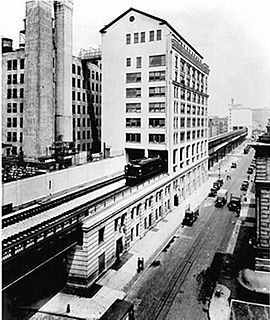
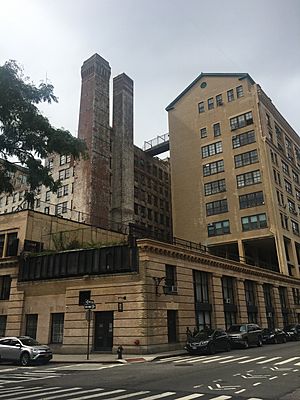
In 1847, the City of New York authorized the construction of railroad tracks along Tenth and Eleventh Avenues on Manhattan's West Side. The street-level tracks were used by the New York Central Railroad's freight trains, which shipped commodities such as coal, dairy products, and beef. For safety the railroad hired "West Side cowboys", men who rode horses and waved flags in front of the trains. However, so many accidents occurred between freight trains and other traffic that the nickname "Death Avenue" was given to Tenth and Eleventh Avenues. In 1910, one organization estimated that there had been 548 deaths and 1,574 injuries over the years along Eleventh Avenue.
Public debate about the hazard began during the early 1900s. In 1929 the city, the state, and New York Central agreed on the West Side Improvement Project, conceived by New York City park commissioner Robert Moses. The 13-mile (21 km) project eliminated 105 street-level railroad crossings, added 32 acres (13 ha) to Riverside Park, and included construction of the West Side Elevated Highway. The plans also included the construction of the St. John's Freight Terminal at Spring Street, which was completed in 1936 and replaced the street-level St. John's Park Terminal in present-day Tribeca. The West Side Improvement cost more than $150 million, worth about $2.56 billion in 2022 dollars. The last stretch of street-level track was removed from Eleventh Avenue in 1941.
The first train on the High Line viaduct, part of New York Central's West Side Line, ran along the structure in 1933. The elevated structure was dedicated on June 29, 1934, and was the first part of the West Side Improvement Project to be completed. The High Line, which originally ran from 35th Street to St. John's Freight Terminal, was designed to go through the center of blocks rather than over an avenue. As a result, the viaduct's construction necessitated the demolition of 640 buildings. It connected directly to factories and warehouses, allowing trains to load and unload inside buildings. Milk, meat, produce, and raw and manufactured goods could be transported and unloaded without disturbing street traffic. This reduced the load on the Bell Laboratories Building (which has housed the Westbeth Artists Community since 1970) and the former Nabisco plant in Chelsea Market, which were served from protected sidings in the buildings.
The line also passed under the Western Electric complex at Washington Street. Although the section still existed as of May 2008[update], it is not connected to the developed park.
Abandonment
The growth of interstate trucking during the 1950s led to a drop in rail traffic throughout the U.S. St. John's Freight Terminal was abandoned in 1960, and the southernmost section of the line was demolished in the following decade due to low use. The West Village Apartments were then built on part of the former segment's right of way. The demolished section began at Bank Street and ran down Washington Street to Spring Street (just north of Canal Street).
By 1978, the High Line viaduct was used to deliver just two carloads of cargo per week. The viaduct was shut down in 1980, when owner Conrail had to disconnect the viaduct from the rest of the national rail system for a year. The closure was necessitated as a result of the construction of Javits Center at 34th Street, which required that the curve at 35th Street be rebuilt. The last train on the viaduct was a three-car consist carrying frozen turkeys. During the time the viaduct was disconnected, two large customers along the route moved to New Jersey. The curve to the viaduct from 35th Street was demolished during the construction of Javits Center and was replaced by the current curve at 34th Street. The tracks leading to the High Line were reconnected in 1981, but as there were no more customers along the route, the curve at 34th Street was never completed, and the viaduct did not see any further usage. At this point, Conrail still owned the right of way and the tracks.
During the mid-1980s, a group of property owners with land under the line lobbied for the demolition of the entire structure. Peter Obletz, a Chelsea resident, activist, and railroad enthusiast, challenged the demolition efforts in court and tried to re-establish rail service on the line. Obletz offered to buy the viaduct for $10 in order to run a small amount of freight trains on the line, and Conrail accepted, mainly because demolition would have cost $5 million. However, this offer was also disputed in court. By 1988, the Metropolitan Transportation Authority was negotiating with Conrail for the possibility for using the line's right of way to construct a light rail route. These negotiations did not proceed further, and by the end of the 1980s, it was expected that the High Line would be demolished.
As part of the construction of the Empire Connection to Penn Station, which opened in spring 1991, the West Side Line tracks north of 35th Street were routed to the new Empire Connection tunnel to Penn Station. A small section of the High Line in the West Village, from Bank to Gansevoort Streets, was taken apart in 1991 despite objections by preservationists. The remaining riveted-steel elevated structure was unused and in disrepair during the 1990s, but it remained structurally sound. Around this time, it became known to urban explorers and local residents for the tough, drought-tolerant wild grasses, shrubs (such as sumac) and rugged trees which had sprung up in the gravel along the abandoned railway. The administration of mayor Rudy Giuliani planned to demolish the structure. The Interstate Commerce Commission approved plans to demolish the structure in 1992, but demolition was delayed due to disputes between various city government agencies and the railroad companies. Ownership of the viaduct ultimately passed to CSX Transportation in 1999.
Repurposing proposal
A nonprofit organization called Friends of the High Line was formed in October 1999 by Joshua David and Robert Hammond. They advocated its preservation and reuse as public open space, an elevated park or greenway similar to the Promenade Plantée in Paris. The organization was initially a small community group advocating the High Line's preservation and transformation when the structure was threatened with demolition during Rudy Giuliani’s second term as mayor. In 2000, CSX Transportation gave photographer Joel Sternfeld permission to photograph it for a year. Sternfeld's photographs of its meadow-like natural beauty, discussed in an episode of the documentary series Great Museums, were used at public meetings when the subject of saving the High Line was discussed. Mary Boone's art gallery, as well as Martha Stewart and Edward Norton, hosted fundraising benefits for the High Line in 2001 and 2002 respectively. Fashion designer Diane von Fürstenberg (who had moved her New York City headquarters to the Meatpacking District in 1997) and her husband, Barry Diller, also organized fundraising events in her studio.
In 2003, Friends of the High Line sponsored a design competition that attracted more than 720 participants from 38 countries. Proposals included a sculpture garden, an elongated swimming pool, and a linear amusement park/campground. In July 2003, Edward Norton and Robert Caro hosted a benefit event at Grand Central Terminal, where the submissions for the design contest were exhibited. The same month, a bipartisan group of city officials began petitioning the federal Surface Transportation Board to hand over title to the viaduct for park use. In anticipation of this handover, the administration of Mayor Michael Bloomberg announced plans for a High Line park that September. The following year, the New York City government committed $50 million to establish the proposed park. Mayor Bloomberg and City Council speakers Gifford Miller and Christine C. Quinn were among the major supporters. Fundraising for the park raised a total of over $150 million (equivalent to $204,607,000 in 2022). The Surface Transportation Board issued a certificate of interim trail use on June 13, 2005, allowing the city to remove most of the line from the national rail system. Ownership officially passed from CSX to the city that November.
Reconstruction and design
On April 10, 2006, Mayor Bloomberg presided over a ceremony to mark the beginning of construction. The park was designed by James Corner's New York-based landscape architecture firm Field Operations and architects Diller Scofidio + Renfro, with garden design by Piet Oudolf of the Netherlands, lighting design from L'Observatoire International, and engineering design by Buro Happold and Robert Silman Associates. New York City Department of City Planning director and city planning commission chair Amanda Burden contributed to the project's development. Major supporters included Philip Falcone, Diane von Fürstenberg, Barry Diller, and von Fürstenberg's children Alexander and Tatiana von Fürstenberg. Hotel developer Andre Balazs, owner of the Chateau Marmont in Los Angeles, built the 337-room Standard Hotel straddling the High Line at West 13th Street.
The southernmost section, from Gansevoort Street to 20th Street, opened as a city park on June 8, 2009. The section includes five stairways and elevators at 14th Street and 16th Street. Around the same time, construction of the second section began. A ribbon-cutting ceremony was held on June 7, 2011 to open the second section (from 20th Street to 30th Street), with Mayor Michael Bloomberg, New York City Council speaker Christine Quinn, Manhattan Borough President Scott Stringer and Congressman Jerrold Nadler in attendance. CSX Transportation, owner of the northernmost section from 30th to 34th Streets, agreed in principle to donate the section to the city in 2011; the Related Companies, which owns development rights for the West Side Rail Yards, agreed not to tear down the spur crossing 10th Avenue. Construction on the final section was started in September 2012.
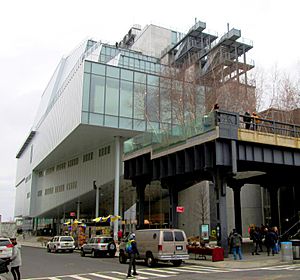
A ribbon-cutting ceremony for the High Line's third phase was held on September 20, 2014, followed the next day by the opening of its third section and a procession down the park. The third phase, costing $76 million, was divided into two parts. The first part (costing $75 million) is from the end of phase 2 of the line to its terminus at 34th Street, west of 11th Avenue. The second part, a spur above Tenth Avenue and 30th Street, has room to install artworks curated by the public art program. The spur was scheduled to open by 2018, but was then delayed to April 2019, and later to June 2019. It opened on June 4, 2019, with the installation of a plinth as its initial artwork. It contains entrances to 10 Hudson Yards, built above the spur.
The High Line closed temporarily in early 2020 during the COVID-19 pandemic in New York City; while most parks remained open during the pandemic, the High Line is a linear park with few means to spread out for social distancing measures. The High Line reopened on July 16, 2020, with limited capacity: the section between Gansevoort and 23rd streets were only open to visitors with timed-entry passes, and were only able to walk northbound from Gansevoort Street, with the other access points being for egress only. As of January 2021[update], weekend admissions still required a pass but weekday admissions did not.
On January 11, 2021, Governor Andrew Cuomo announced proposals to extend the High Line east to Moynihan Train Hall and north to Hudson River Park. The 1,200-foot (370 m) Moynihan Train Hall spur, planned to cost $60 million, would run east along 30th Street for one block to Dyer Avenue, then turn north to 31st Street, connecting to a public space within Manhattan West that ends at the west side of Ninth Avenue directly across from Moynihan Train Hall. A second spur would diverge from the Phase 3 walkway at 34th Street, running north to the Javits Center and then turning west to cross the West Side Highway to Hudson River Park. At the time of the spurs' announcement, neither of the projects had been funded.
Friends of the High Line
The line is maintained by Friends of the High Line, which was founded by Joshua David and Robert Hammond. The organization is credited with saving the structure by rallying public support for the park and convincing Mayor Michael Bloomberg’s administration in 2002 to support the project by filing a request with the Surface Transportation Board to create a public trail on the site. Friends of the High Line played a role in the line's visual aesthetic, holding a competition in conjunction with the city of New York in 2004 to determine the design team which would lead the project. Since the park's opening in 2009, Friends of the High Line has had an agreement with the New York City Department of Parks and Recreation to serve as its primary steward. The organization is responsible for the daily operation and maintenance of the park, with an annual budget of over $5 million. It has an annual operating budget of $11.5 million, in addition to capital construction and management and fundraising expenses.
Friends of the High Line has raised more than $150 million in public and private funds toward the construction of the first two sections of the park. Unlike the first two phases, to which the city significantly contributed, Friends of the High Line was responsible for raising funds for phase three (an estimated $35 million). The organization raises over 90 percent of the High Line's annual operating budget from private donations. When the city donated $5 million to the High Line in 2012, there was criticism that most city parks had received less funding that year, especially since Friends of the High Line had raised an extra $85 million that year.
The organization has an office on Washington Street, near the park's southern end. It has 80 full-time, year-round employees and about 150 full-time summer employees. Friends of the High Line has been run by president and co-founder Josh David after executive director Jenny Gersten stepped down in 2014. Co-founder Robert Hammond served as executive director until he stepped down in February 2013. Friends of the High Line has a 38-member board of directors consisting of many New York City businesspeople and philanthropists, including Amanda Burden of Bloomberg Associates, Jane Lauder of Estée Lauder Companies, Jon Stryker of the Arcus Foundation and Darren Walker of the Ford Foundation.
Impact
Since its opening, the High Line has become one of the most popular visitors attractions in New York City. By September 2014, the park had nearly five million visitors annually, and in 2019, it had eight million visitors per year. Most of these visits came from tourists; a 2019 study found that tourists made up four-fifths of the High Line's total visitor count. Residents quoted in The New York Times stated that the park has become a "tourist-clogged catwalk" since it opened, and one critic called a "tourist-clogged cattle chute".
Gentrification and development
The recycling of the rail line into an urban park and tourist attraction has revitalized Chelsea, which was "gritty" and in generally poor condition during the late twentieth century. It has also spurred real-estate development in the neighborhoods along the line. According to mayor Bloomberg, by 2009 more than 30 projects were planned or under construction nearby, and by 2016 more than 11 projects were under construction. It has also helped raise the value of properties directly adjacent to the High Line by an average of 10 percent over properties a few blocks away. At least 20 properties abutting the High Line have sold for at least $10 million since the park's opening in 2009, with an apartment in a building directly adjacent to the park selling for an average of $6 million. Apartments located near Phase 1 of the High Line are, on average, more than twice as costly as those between Seventh and Eighth Avenues (two blocks east). In August 2016, the park continued to increase real-estate values along it in an example of the halo effect.
Residents who have bought apartments next to the High Line adapted to its presence in various ways, but most responses were positive. However, many established businesses in west Chelsea have closed due to loss of their neighborhood customer base or rent increases. Chelsea has significant minority communities, many of whom live in two large public housing developments. In a 2017 interview, Friends of the High Line co-founder Robert Hammond said that he "failed" the community; the High Line did not fulfill its original purpose of serving the surrounding neighborhood, which had become demographically divided around the park.
Due to the High Line's popularity, several museums were proposed or built along its path. The Dia Art Foundation considered (but rejected) a proposal to build a museum at the Gansevoort Street terminus. On that site, the Whitney Museum has built a new home for its collection of American art. The building, designed by Renzo Piano, opened on May 1, 2015.
Projects in other cities
The High Line's success in New York City has encouraged leaders in other cities such as Chicago mayor Rahm Emanuel, who sees it as "a symbol and catalyst" for gentrifying neighborhoods. Several cities nationwide have plans to renovate railroad infrastructure into parkland, including Philadelphia's Rail Park, Atlanta's Belt Line, and Chicago's Bloomingdale Trail. The High Line has helped pioneer the creation of elevated parks worldwide. In Queens, the Queensway (a proposed aerial rail trail) is being considered for reactivation along the right-of-way of the former Long Island Rail Road Rockaway Beach Branch. Other cities around the world are planning elevated rails-to-trails parks in what a writer has called the "High Line effect".
According to some estimates, it costs substantially less to redevelop an abandoned urban rail line into a linear park than to demolish it. Landscape architect James Corner (who led the High Line's design team) noted that "The High Line is not easily replicable in other cities," however, observing that building a "cool park" requires a "framework" of neighborhoods around it to succeed.
In 2016, Friends of the High Line launched the High Line Network to support similar infrastructure re-use projects being developed in other cities. As of 2017[update], there are 19 projects in the network, including River LA, the Atlanta Beltline, Crissy Field, Dequindre Cut, the Lowline, Klyde Warren Park, the Bentway, Bergen Arches, Destination Crenshaw and the Trinity River Project.
See also
 In Spanish: High Line (Nueva York) para niños
In Spanish: High Line (Nueva York) para niños


